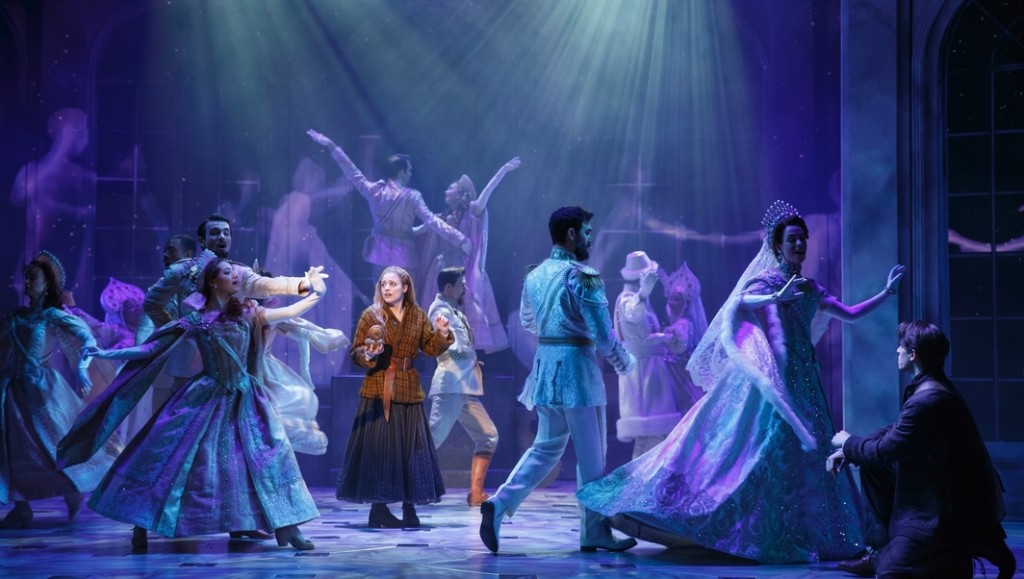To See or Not to See: Anastasia

Fans of the animated film Anastasia have something to rejoice: a Broadway-bound musical adaptation of the film just opened at the Hartford Stage in Connecticut. Helmed by the film’s original songwriters Stephen Flaherty and Lynn Ahrens, original screenwriter Terrence McNally, and Tony-winning director Darko Tresnjak (whose A Gentleman’s Guide to Love and Murder was the essential Broadway ticket of 2013-2014), Anastasia the musical seeks to expand upon the story in new and interesting ways.
Don Bluth’s Anastasia follows two Russian con men– Dmitry and Vlad– in their quest to prove that an amnesiac young woman is actually a long-lost Romanov princess. The film is a charming adaptation of a stage play and film of the same name concerning the fate of the Grand Duchess Anastasia Nikolaevna, fourth daughter of the last Tsar of Russia and rumored survivor of her family’s execution by the Bolsheviks in 1918. Yes, I just used “charming” to describe a film about one of the most tragic and notorious crimes of the twentieth century. That’s because the animated film is more fairy tale than history– it sanitizes history by completely sidestepping the bloody fate of the Romanovs, creating a perfect romance between two sparring characters, and enlivening the story with gorgeous music. This combination made Anastasia one of the best loved animated films in the last thirty years– take that, Disney.
Is the new stage musical a worthy adaptation of the beloved film?
Frankly, there is a lot of potential here, though aspects of the story have been substantially reworked. This new musical is not simply a live version of the film. Old characters have been dropped (R.I.P. Bartok and Pooka), new characters have been added, and surviving characters have been reimagined. This new production is also more mindful of the bloody history from which its story emerges, and a number of historical Easter eggs litter the production. In short, this is an adult version of Anastasia, and it’s as if the story itself grew up with the young audiences that made the film a hit in 1997.
One of the most interesting choices the creative team made was to tweak the character of Anya. She is now a mix of Anya from the animated film and Anna from the stage play and its 1956 adaptation. To that end, the new Anya has clearly been traumatized, and you get the sense that her amnesia stems, not from hitting her head on a train platform as in the animated feature, but from the genuine shock of having witnessed the execution of her family. This is a young woman who suffers from PTSD, who shakes when she hears gun shots, and who had to fight for her survival. All of these details make her character more complex and, well, human. Christy Altomare‘s Anya is spirited, intelligent, and emotionally troubled, and her lovely soprano gives life to these much-loved songs.
The creative team is less successful with Dmitry. Though Derek Klena plays him with ease, the character is underdeveloped. Instead of being a former servant in the royal palace, stage Dmitry’s childhood past intersected with Anya’s in different– and frankly less interesting– ways. Furthermore, the revelation that his father was an anarchist who was imprisoned and probably executed had nothing to do with the person Dmitry grew up to become. We have no indication of how that backstory might have shaped his attitudes and beliefs.
It’s worth noting that both Altomare and Klena’s performances successfully met the very high expectations of this Anastasia aficionado. Their chemistry is perhaps less overt than it is in the film, but they have a comfortable romance with one another that feels natural.
The songs have been changed as well. Don’t worry– your favorites are still here, like “Once upon a December,” “Journey to the Past,” and “Paris Holds the Key to Your Heart.” What’s more: the current cast sings them beautifully. But new songs, like “The Countess and the Common Man” and “Crossing the Bridge,” fit in splendidly. The most notable song absence is “In the Dark of the Night,” which is sung in the film by the villain Rasputin. (The creative team probably realized the absurdity of having Rasputin as the principle villain, and he has been cut from the show.) In yet another brilliant move, the beautiful, dramatic bridge of “In the Dark of the Night” is repurposed to stirring effect: it becomes “Stay, I Pray You,” the moving, melancholy song sung by soon-to-be-exiled Russians at a train station as they are about to depart their homeland forever.
The new villain is a Soviet (because, of course he is) by the name of Gleb. While his character is interesting and unexpected in the first act, he is criminally underused in the second. There is a lot of potential with this character, since he is torn between his high-minded ideals and human compassion. But, the character is not quite there yet– I sincerely hope the creative team fleshes him out before the Broadway transfer, since they could do exciting things with him. Moreover, Manoel Felciano plays the part exceedingly well, and I’d like to see his rich voice given at least one more song.
The most successful changes are with the characters Vlad (John Bolton) and Sophie. Vlad, one of the conspirers with Dmitri, is reimagined as a shabby court pretender and interloper, who clearly can charm his way into any room. Sophie, the Dowager Empress’s lady-in-waiting, is instead Countess Lily in the stage version. She is a sharp and lively spitfire, as opposed to the sweet, vapid character in the film. Lily is played to perfection by Caroline O’Connor, who steals the show every time she is on stage. A particular highlight was the witty “Land of Yesterday,” which pokes fun at the woe-is-me pretensions of the exiled “white” Russians in Paris. The Dowager Empress appears just as dignified as she does in the film– casting Mary Beth Peil in the role was a genius move, as she exudes both matriarchal authority and familiar warmth.
The production itself is lovely to behold. Linda Cho‘s costumes are literally breathtaking (I think I gasped out loud when the Empress Alexandra stepped onto stage in her glittering court gown at the start of the show) and Alexander Dodge‘s set design made the most of the small space. Donald Holder‘s lighting design and Aaron Rhyne‘s projections also gave the production a visually sumptuous look.
It will be interesting to see how the creative team continues to develop Anastasia before it hits Broadway next season. I would like to see them work on the show’s opening– it fell flat overall, even though the individual components were great. Act I in general needs some work, and the characters Dmitry and Gleb need to be fleshed out. Overall, I’m optimistic: I saw enough potential at the Hartford Stage to believe that Anastasia could be an enchanting production.
Photo Credit: Joan Marcus


Discussion about this post